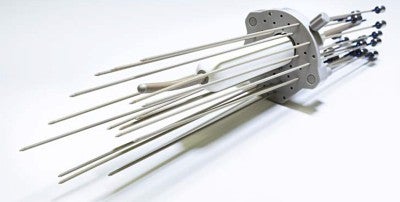
In 2020, the American Society for Radiation Oncology, issued its first clinical guidelines to treat individuals with nonmetastatic cervical cancer. The guidelines note that cervical cancer treatment has dramatically advanced over the past 20 years, with intensity-modulated radiation therapy (IMRT) and image-guided brachytherapy, in particular, resulting in better patient outcomes with fewer complications.
The guidelines strongly recommend brachytherapy for people receiving definitive radiation or chemoradiation and note that neither stereotactic body radiation therapy (SBRT) nor IMRT alone is a suitable substitute for brachytherapy.
At Lehigh Valley Hospital (LVH)–Cedar Crest and LVH–Pocono, individuals can now receive a highly targeted form of interstitial brachytherapy delivered through a template with openings that guide the needles delivering radiation into place.
The treatment, Syed-Neblett template brachytherapy, is appropriate for people with newly diagnosed or recurrent cervical cancer who have had a hysterectomy, or for those with locally advanced cervical cancer with intact uteruses who may benefit from a high dose of targeted radiation.
“The goal is to deliver radiation to the cervix and the adjacent tissue, as well as the upper portion of the vagina, and spare surrounding structures,” says Christine Kim, MD, with LVPG Gynecology, Lehigh Valley Topper Cancer Institute.

